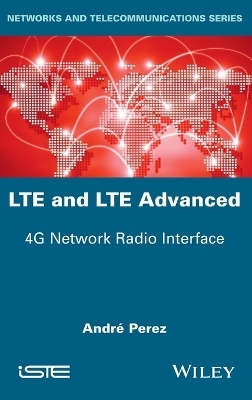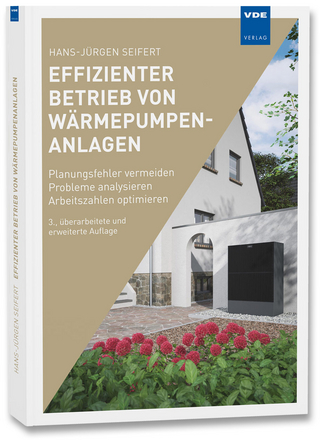
LTE and LTE Advanced
ISTE Ltd and John Wiley & Sons Inc (Verlag)
978-1-84821-844-4 (ISBN)
This book presents the technical characteristics of the two radio network interfaces of mobile 4G, LTE and LTE Advanced, based on Release 8, 9 and 10 of the 3GPP specifications.
Points covered include a detailed description of various components of the radio interface. RRC signaling messages used to establish the connection, enabling the security, the paging, the establishment and the release of dedicated and default support and the handover. The PDCP ensures the security of the transmission and allows the recovery during handover and the compression of the headers. The RLC protocol defines the transmission modes with or without acknowledgment. The MAC protocol determines the random access, the data transfer, the timing advance, the scheduling and the discontinuous reception. The physical layer includes a description of the methods of multiplexing (time, frequency and space) and the various signals and physical channels.
André Perez is a consultant and teacher in networks and telecommunications. He works with industrialists and operators regarding architecture studies and leads training on the 4G and IMS networks for NEXCOM.
Preface xiii
List of Acronyms xv
Chapter 1. General Characteristics 1
1.1. Network architecture 1
1.1.1. EPS network 1
1.1.2. MBMS network 8
1.1.3. LCS network 11
1.2. Bearer types 14
1.2.1. Bearer structure 14
1.2.2. Quality of Service 15
1.3. Radio interface 17
1.3.1. Structure of the radio interface 18
1.3.2. NAS protocol 19
1.3.3. RRC protocol 20
1.3.4. Data link layer 21
1.3.5. Logical channels 22
1.3.6. Transport channels 23
1.3.7. Physical layer 24
1.3.8. Physical signals 26
1.3.9. Physical channels 27
1.3.10. Mobile categories 29
1.4. Network procedures 30
1.4.1. Connection procedure 30
1.4.2. Attachment procedure 30
1.4.3. Restoration procedure of the default bearer 36
1.4.4. Establishment procedure of a dedicated bearer 39
1.4.5. Location update procedure 41
1.4.6. Handover procedure 43
1.4.7. Multicast bearer establishment procedure 45
Chapter 2. NAS Protocol 49
2.1. Attachment 49
2.1.1. Procedure 49
2.1.2. Message structure 51
2.2. Session establishment 55
2.2.1. Procedure 55
2.2.2. Message structure 57
Chapter 3. RRC Protocol 63
3.1. System information 63
3.1.1. MIB message 64
3.1.2. SIB1 message 64
3.1.3. SIB2 message 66
3.1.4. SIB3 message 67
3.1.5. SIB4 message 68
3.1.6. SIB5 message 68
3.1.7. SIB6 message 68
3.1.8. SIB7 message 69
3.1.9. SIB8 message 69
3.1.10. SIB9 message 70
3.1.11. SIB10 message 70
3.1.12. SIB11 message 71
3.1.13. SIB12 message 71
3.1.14. SIB13 message 72
3.2. Connection control 72
3.2.1. Paging 72
3.2.2. Connection establishment 73
3.2.3. Security activation 75
3.2.4. Connection reconfiguration 76
3.2.5. Connection re-establishment 78
3.2.6. Connection release 79
3.3. Measurements 80
3.3.1. Introduction 80
3.3.2. Objects 80
3.3.3. Events 81
3.3.4. Measurement filtering 85
3.3.5. Measurement report 85
3.4. Broadcast control 85
3.4.1. Configuration of frames and subframes 85
3.4.2. MCCH logical channel scheduling 86
3.4.3. MTCH logical channel scheduling 87
3.4.4. Counting 89
Chapter 4. Data Link Layer 91
4.1. PDCP protocol 91
4.1.1. Procedures 92
4.1.2. Operations 94
4.1.3. Protocol structure 97
4.2. RLC protocol 99
4.2.1. Operations 100
4.2.2. Protocol structure 102
4.3. MAC protocol 107
4.3.1. Operations 107
4.3.2. Protocol structure 111
4.3.3. Control elements 114
Chapter 5. Physical Layer 117
5.1. Frequency plan 117
5.1.1. Frequency bands 117
5.1.2. Radio channel 119
5.1.3. Aggregation of the radio channels 121
5.1.4. Numbering of radio channels 122
5.2. Multiplexing structure 125
5.2.1. Time-division multiplexing 125
5.2.2. Resource block 130
5.2.3. Resource element group 132
5.3. Transmission chain 133
5.3.1. Error detection codes 135
5.3.2. Error correction codes 136
5.3.3. Modulation 137
5.3.4. Antenna ports 138
5.3.5. Transmission modes 140
5.3.6. Inverse Fast Fourier Transform 143
5.3.7. Configuration of the transmission 144
5.3.8. Antenna configurations 145
Chapter 6. Downlink Physical Signals 149
6.1. PSS physical signal 149
6.1.1. Sequence generation 150
6.1.2. Mapping on the resource elements 150
6.2. SSS physical signal 152
6.2.1. Sequence generation 152
6.2.2. Mapping on the resource elements 153
6.3. Cell-Specific RS physical signal 155
6.3.1. Sequence generation 155
6.3.2. Mapping on the resource elements 156
6.4. MBSFN RS physical signal 159
6.4.1. Sequence generation 159
6.4.2. Mapping on the resource elements 160
6.5. UE-Specific RS physical signal 162
6.5.1. Sequence generation 162
6.5.2. Mapping on the resource elements 164
6.6. PRS physical signal 168
6.6.1. Sequence generation 169
6.6.2. Mapping on the resource elements 169
6.6.3. Configuration of the subframes 170
6.7. CSI RS physical signal 171
6.7.1. Sequence generation 172
6.7.2. Mapping on the resource elements 173
6.7.3. Configuration of the subframes 174
Chapter 7. Downlink Physical Channels 177
7.1. PBCH physical channel 177
7.1.1. Error detection code 178
7.1.2. Error correction code 178
7.1.3. Rate matching 178
7.1.4. Scrambling 179
7.1.5. Modulation 179
7.1.6. Mapping on the spatial layers 179
7.1.7. Precoding 180
7.1.8. Mapping on the resource elements 181
7.2. PCFICH physical channel 182
7.2.1. CFI information 183
7.2.2. Error correction code 183
7.2.3. Scrambling 184
7.2.4. Modulation 184
7.2.5. Mapping on the spatial layers 184
7.2.6. Precoding 185
7.2.7. Mapping on the resource elements 186
7.3. PHICH physical channel 188
7.3.1. HI information 189
7.3.2. PHICH group 189
7.3.3. Error correction code 190
7.3.4. Modulation 190
7.3.5. Scrambling and spreading 191
7.3.6. Resource group alignment 192
7.3.7. Mapping on the spatial layers 193
7.3.8. Precoding 193
7.3.9. Mapping on the resource elements 195
7.3.10. Assignment of the PHICH physical channel 199
7.4. PDCCH physical channel 200
7.4.1. DCI information 201
7.4.2. Error detection code 207
7.4.3. Error correction code 208
7.4.4. Rate matching 208
7.4.5. Multiplexing 209
7.4.6. Scrambling 209
7.4.7. Modulation 210
7.4.8. Mapping on the spatial layers 210
7.4.9. Precoding 211
7.4.10. Mapping on the resource elements 212
7.4.11. Allocation of physical channel PDCCH 215
7.5. PDSCH physical channel 217
7.5.1. Error detection code 218
7.5.2. Segmentation 219
7.5.3. Error correction code 219
7.5.4. Rate matching 220
7.5.5. Concatenation 221
7.5.6. Scrambling 221
7.5.7. Modulation 222
7.5.8. Mapping on the spatial layers 222
7.5.9. Precoding 224
7.5.10. Mapping on the resource elements 225
7.5.11. Resource allocation 227
7.6. PMCH physical channel 235
7.6.1. Error detection codes 236
7.6.2. Segmentation 236
7.6.3. Error correction code 236
7.6.4. Rate matching 237
7.6.5. Concatenation 237
7.6.6. Scrambling 237
7.6.7. Modulation 238
7.6.8. Mapping on the spatial layers 238
7.6.9. Precoding 238
7.6.10. Mapping on the resource elements 238
Chapter 8. Uplink Physical Signals 241
8.1. DM-RS physical channel 241
8.1.1. DM-RS physical signal associated with PUSCH physical channel 241
8.1.2. DM-RS physical signal associated with the PUCCH physical channel 244
8.2. SRS physical signal 246
8.2.1. Sequence generation 247
8.2.2. Mapping on the resource elements 248
8.2.3. Configuration of the subframes 250
8.2.4. Transmission of the SRS physical signal 252
8.2.5. Power control 254
Chapter 9. Uplink Physical Channels 257
9.1. PRACH physical channel 257
9.1.1. Time structure of the preamble 257
9.1.2. Frequency structure of the preamble 260
9.1.3. Location of the preamble 260
9.1.4. Sequence generation of the preamble 264
9.1.5. Power control 264
9.2. PUCCH physical channel 265
9.2.1. UCI information 266
9.2.2. Formats 1, 1a and 1b 270
9.2.3. Formats 2, 2a and 2b 273
9.2.4. Format 3 278
9.2.5. Configuration of the resource blocks 281
9.2.6. Allocation of the PUCCH physical channel 283
9.2.7. Power control 284
9.3. PUSCH physical channel 285
9.3.1. Error detection code 287
9.3.2. Segmentation 287
9.3.3. Error correction code 288
9.3.4. Rate matching 289
9.3.5. Concatenation 289
9.3.6. Coding of the control data 290
9.3.7. Multiplexing of the control and traffic data 296
9.3.8. Interleaving 296
9.3.9. Scrambling 296
9.3.10. Modulation 297
9.3.11. Mapping on the spatial layers 297
9.3.12. Precoding 299
9.3.13. Mapping on the resource elements 300
9.3.14. Allocation of resources 301
9.3.15. Frequency hopping 303
9.3.16. Power control 306
Chapter 10. Radio Interface Procedures 309
10.1. Access control 309
10.1.1. PRACH physical channel acquisition 309
10.1.2. Random access 311
10.2. Data transfer 316
10.2.1. Scheduling 316
10.2.2. DRX function 319
10.2.3. SPS function 320
10.2.4. HARQ function 322
10.2.5. TTI bundling function 329
Bibliography 331
Index 335
| Verlagsort | London |
|---|---|
| Sprache | englisch |
| Maße | 165 x 241 mm |
| Gewicht | 680 g |
| Themenwelt | Technik ► Elektrotechnik / Energietechnik |
| Technik ► Nachrichtentechnik | |
| ISBN-10 | 1-84821-844-3 / 1848218443 |
| ISBN-13 | 978-1-84821-844-4 / 9781848218444 |
| Zustand | Neuware |
| Informationen gemäß Produktsicherheitsverordnung (GPSR) | |
| Haben Sie eine Frage zum Produkt? |
aus dem Bereich


